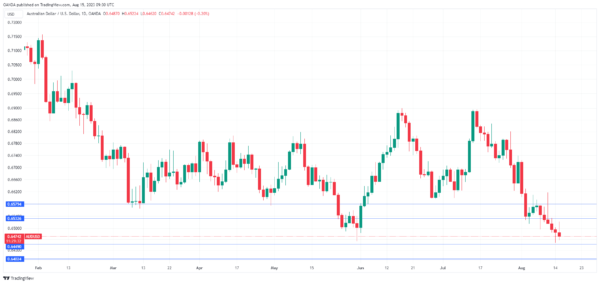- Australian dollar extends losses
- Australia’s wage growth eases to 3.2%
- China’s retail sales decline
The Australian dollar hasn’t recorded a winning daily session in over a week and is in negative territory on Tuesday. In the European session, AUD/USD is trading at 0.6468, down 0.28%. On Monday, the Australian dollar dropped as low as 0.6453, its lowest level since early November 2022.
Australian wage growth eases in the second quarter
Australia’s wage growth ticked lower to 3.6% y/y in the second quarter, compared to 3.7% in Q1. Wages rose 0.8% q/q for a third straight quarter in Q2. The takeaway is that although wage growth remains high, we’re not seeing a rise. That is an encouraging sign for the Reserve Bank of Australia, as higher wages raise the possibility of a wage-price spiral, which would hurt the RBA’s efforts to reduce inflation.
The RBA has made its rate stance very clear, saying that rate hikes remain on the table but any decision will be based on economic data. Today’s wages report is unlikely to cause any shift at the RBA. The probability of a pause is currently 93%, compared to 95% prior to the wage growth release, according to the ASX RBA rate tracker.
Weak wage growth isn’t great news for households, who are seeing their purchasing power erode due to high inflation. The good news is that lower wage growth will make it easier for the RBA to start to trim rates if inflation cooperates and continues to fall.
The RBA minutes, released today, indicated that the RBA viewed the risks to the economy as “finely balanced” between tightening too fast or allowing inflation to remain too high. In the end, the decision to pause was based on weaker economic growth and the “acute financial challenges” that some households faced due to rising rates.
China has posted a host of weak economic data, and the trend continued on Tuesday. Retail sales slowed to 2.5% y/y in July, down from 3.1% in June and well below the 4.5% consensus estimate. The unemployment rate ticked higher to 5.3% in July, up from 5.2% a month earlier. China’s central bank responded by cutting key policy rates today, in an attempt to kick-start the sputtering economy. The surprise move by the central bank has raised speculation that it could trim the 5-year lending prime rate (LPR) next week.
AUD/USD Technical
- AUD/USD is putting pressure on resistance at 0.6449. This is followed by support at 0.6402
- 0.6532 and 0.6579 are the next resistance lines













